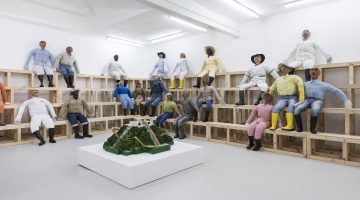“Early Works and The Angel” by deceased artist James Lee Byars will be closing March 16th at Michael Werner Gallery. You should make your way over to see this show if you’re in London. The strange thing about this show is that upon first glance of the work, I thought that Byars was Japanese, or part Japanese at least. But reading more about his history I discovered that he spent time in Japan during the late 50s to 60s, which is where his aesthetic was constructed. Mono-ha comes to mind when looking at the work, and it just so happens that Byars was there – pretty amazing. If you were in Los Angeles to see the Mono-ha exhibit at Blum and Poe I am envious of you, and if you didn’t see it too and live in London, maybe this exhibition might give you some insight into the art scene in Japan during that time.
Byars is said to have an appreciation of ceremony, formal rigor and transient beauty, as well as have a unique sensibility to materials. Many reoccurring materials in his practice include wood, stone, ceramics, and ink on paper. Byars investigates figuration in the works, which may seem hidden at first. “The Angel” is one of his most renowned sculptures which consists hand blown globes that lay on the floor of the gallery arranged to form a stylized figure. A performative component lies stealthly within this work, because each globe was made with a single breath. This allows the work to become more humanized and warms up from its initially cold presence in the room. A couple works stand out, and have a lighter more approachable sensibility to them. The “Untitled (Tantric Figure)” works seem to have a subtle humorous quality that can be determined through the lens of contemporary times. Almost like characters from a cartoon, these pieces are hard to not smile at. We probably wont be able to know Byars’ true intentions for these works, but they are quite amusing and pleasant to look at.
For more information on this exhibition you can look toward a fully illustrated catalogue with words by Dave Hickey, or visit Michael Werner Gallery’s website here.
-Contributed by Gregory Ito






